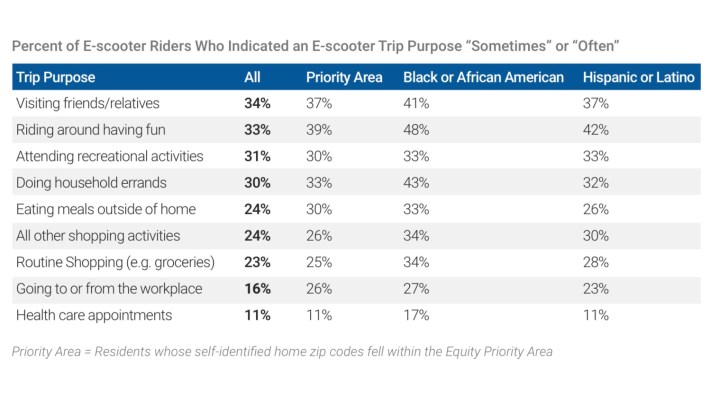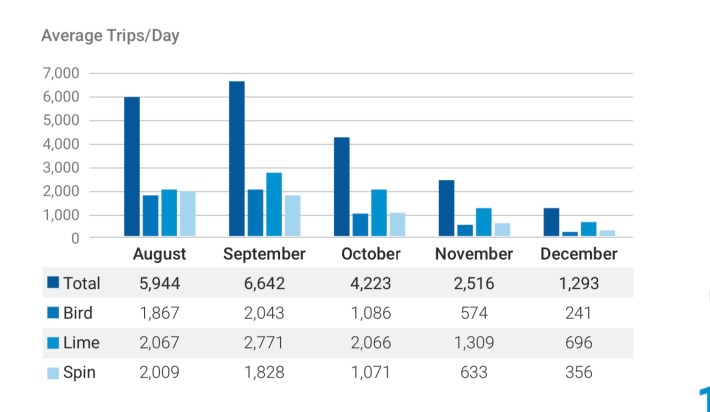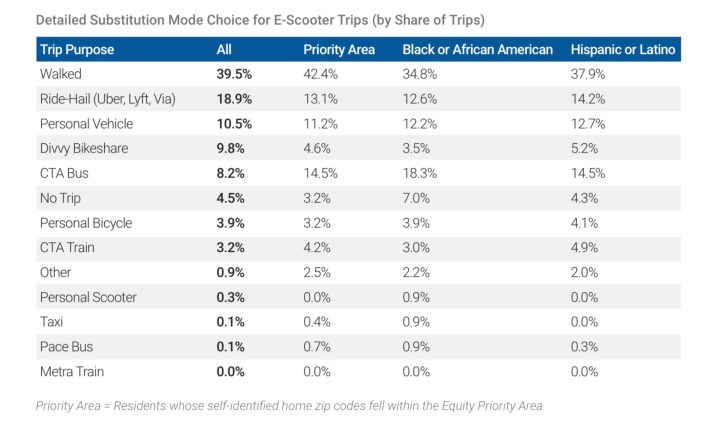The Chicago Department of Transportation recently released their evaluation of the 2020 Scooter Pilot (PDF) which lasted four months, from mid-August to mid-December. Last year’s pilot program significantly expanded the number of available scooters (10,000 in 2020 versus 2,500 in 2019) and the service area (212 square miles versus 50 in 2019) in which scooters could be ridden. Another big differences was that riders were required to lock the scooters to a bike rack or pole at the end of their ride. Scooter vendors Lime, Bird, and Spin were required to deploy half of their devices throughout priority areas on the South and West sides.
According to CDOT’s report on 2020’s scooter pilot, an average of 7,415 e-scooters per day were deployed and available on Chicago’s streets during the 2020 pilot. CDOT estimates a little over 540,000 trips were taken during the pilot which resulted in an average of 0.59 trips per scooter per day. Close to a quarter (23 percent) of scooter trips originated in the Equity Priority Area. Most scooter users completed short-distance rides with an average of 2.10 miles, rode for an average trip duration of 18.50 minutes, and typically paid $8 for their ride. When surveyed about their shared e-scooter usage in the past month, 59 percent of riders took 1-3 rides. Close to a quarter (23 percent) of riders only took one trip. A small percentage of riders (8.5 percent) took more than 10 trips in a month. This demographic was responsible for more than a third of all e-scooter trips.
I’m a big fan of surveys so I was interested in the results CDOT obtained via user surveys. Many e-scooter users said they would have walked or biked if e-scooters had not been available. Some stated they would have used rideshare or driven alone. The vast majority (90 percent) of scooter users who were surveyed agreed that e-scooters made it easier to reach a destination or complete a trip. 60% agreed that shared e-scooters are useful in meeting daily transportation needs. Interestingly, no dominant trip purpose emerged. One third of riders said they “sometimes” or “often” used e-scooters to make social visits, to ride for enjoyment, to attend recreational activities, or to do household errands. Riders who live in the Equity Priority Area were 1.6 times more likely to say they “sometimes” or “often” used a shared e-scooter to get to or from work than riders citywide. E-scooter ridership was concentrated on the weekend, Friday through Sunday, with over half of all trips made on these three days of the week.

Source: City of Chicago
Scooter users were more likely to belong to the 25-34 age group, almost twice as likely to have a Bachelor’s degree, 1.7 times more likely to identify as white than average, and 1.3 times more likely to identify as male. The majority of scooter trips originated in just a few neighborhoods on the North and Near West side of the city.

Source: City of Chicago
Despite the fleet and service area increase, total scooter use decreased. The city acknowledged that COVID-19 had an impact on scooter ridership stating, “it is very difficult to understand the full nature and extent of impacts the COVID-19 pandemic may have had on shaping outcomes in the 2020 pilot.” The city still looked at potential pandemic influencers on ridership such as weather and COVID-related activity restrictions. COVID-19 delayed the launch of the 2020 scooter pilot and thus the city looked at the effects of weather and season on ridership. “A regression analysis was conducted to compare total daily trips with daily high temperature, daily low temperature, and daily precipitation. This analysis found a statistically significant correlation: for every degree increase in daily high temperature 147 more e-scooter trips are expected”.
As far as COVID-related activity restrictions, 10 percent of non-e-scooter users surveyed said COVID-19 prevented them from using a shared e-scooter because they did not feel safe or did not have anywhere to go. Interestingly enough, Divvy hit record ridership levels in August, September and October 2020.

Source: City of Chicago
With most micromobility options, how they impact transit ridership and vehicle trips is important. Fifty-three percent of scooter users indicated that they would have walked or biked if an e-scooter had not been available. Close to 30 percent (29.5) stated they would have driven or used rideshare, 11.6 percent would have taken transit instead, and 4.5 percent would not have made the trip at all. Whether or not scooters complimented or substituted transit trips was also analyzed. Thirty six percent of scooter users used an e-scooter to connect to transit at least once. Approximately 22 percent of riders surveyed said they “often” used a scooter to avoid using transit because of COVID-19 concerns. Overall, the average daily trips (4,500) equated to 1 percent of total CTA daily weekday ridership (457,000) during the pilot.
Bikeshare fans may be curious about how e-scooters interacted with bikeshare. Fifty percent of scooter riders had never used Divvy which suggests scooters introduced many people to shared micromobility. Close to a quarter (23 percent) of scooter riders reported having a Divvy membership. Ten percent of scooter users reported that they would have used Divvy if scooters had not been available.

Source: City of Chicago
Scooters have had plenty of critics. However, in September 2020 we reported that scooter-related complaints to the city decreased about 60 percent during the 2020 pilot versus 2019’s scooter pilot. The city reported that 337 reports were filed through 311 during the 2020 pilot. The average number of 311 reports-per-day-per-device was 75 percent lower than in 2019. Nearly half of 311 reports were either blank or did not list a specific violation of pilot rules such as wanting all e-scooters gone from reporter’s neighborhood, e-scooters locked to a tree, or a general dislike of scooters. The most common valid complaint was the issue of a scooter being locked to private property like a fence or gate. The second and third most common complaints were e-scooters locked to a handicap pole and scooter blocking the public way.
As far as vendor violations of pilot rules, the most common violations were failure to rebalance required share of scooters in 20 priority sub-areas, failure to deploy minimum number of scooters, and failure to rebalance scooters in Equity Priority Area. Bird received the vast majority of violations, 247 violations, compared to eight for Lime, and one for Spin.
There’s lots more information in the city’s official report on the 2020 scooter pilot and I highly recommend you check it out. It will be interesting to see if and how shared scooters will fit into the Chicago transportation landscape. I personally think there’s plenty of space for more micromobility options.




